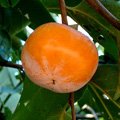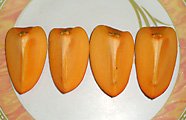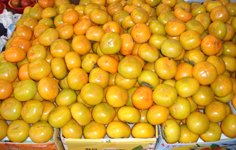Persimmon fruit Nutrition facts
Persimmon fruit is a golden yellow, round or oval, flavorful, smooth textured delicacy of the Far East-Asian origin. Its sweet, delicious flesh is packed with many health-promoting nutrients such as vitamins, minerals, and antioxidants vital for optimum health.
Botanically, persimmons belong to the family of Ebenaceae, in the genus: Diospyros. This delicate fruit is native to China. From China, it spread to the Korean peninsula and Japan (Kaki-柿) a very long time ago and later was introduced to California during the middle of the 19th century.
Scientific name: Diospyros virginiana.

|
 |
| Persimmon tree with fruit. (Diospyros virginiana) Photo: by Takekaju) |
Delicious Persimmon slices. |
Persimmons are either multi-trunked or single-stemmed deciduous trees, which may grow up to 25 ft in height. They grow best in areas where winters are moderate and summers relatively mild.
Persimmon trees are classified broadly into two general categories: those that bear "astringent fruit" (while unripe) and those that bear "non-astringent" fruits. An astringent cultivar, which is commonly cultivated in Japan known as “Hachiya,” is high in tannins and must be allowed to ripen completely on the tree itself until it attains jelly-soft consistency before accepted to be fit for consumption. A non-astringent persimmon, on the other hand, contains less tannin and can be eaten while it is crispy, as in apples. Astringency can be removed by treating the fruit with carbon dioxide or alcohol.
During each season, the persimmon tree bears many fruits that vary by cultivar from spherical to heart to flattened or squash-like in shape. They also greatly vary in size from as little as a few ounces to more than a pound. The color of the fruit ranges from light yellow-orange to dark orange-red. The entire fruit is edible except for the seed and calyx.
Astringent varieties: Eureka, Hachiya, Saijo, Tamopan, Tanenashi, Triumph, etc.
non-astringent varieties: Fuyu (Fuyugaki), Gosho/Giant Fuyu/O'Gosho, Imoto, Izu, Jiro, Maekawajiro, Okugosho, Suruga, etc.
Health benefits of persimmon fruit
Persimmon fruit is moderately high in calories (provides 70 calories/100 g) but very low in fats. Its smooth textured flesh is a very good source of dietary fiber. 100 g of fresh fruit holds 3.6 g or 9.5% of the recommended daily intake of soluble and insoluble fiber.
Persimmons contain health benefiting flavonoid polyphenolic antioxidants such as catechins and gallocatechin in addition to having an important anti-tumor compound, betulinic acid. Catechins were found to have anti-infective, anti-inflammatory, and anti-hemorrhagic (prevents bleeding from small blood vessels) properties.
Some of the other antioxidant compounds found abundantly in this fruit are vitamin-A, β-carotene, lycopene, lutein, zeaxanthin, and cryptoxanthin. Together, these compounds work as protective scavengers against oxygen-derived free radicals and reactive oxygen species (ROS) that play a role in aging and various disease processes.
Zeaxanthin, an important dietary carotenoid, is selectively absorbed into the retinal macula lutea in the eyes where it is thought to provide antioxidant and protective light-filtering functions. It, thus, helps prevent "Age-related macular related macular disease"(ARMD) in the elderly.
Persimmons are also a very good source of vitamin-C, another powerful antioxidant (especially native Chinese and American persimmons; provide 80% of DRI). Regular consumption of foods rich in vitamin C helps the body develop resistance against infectious agents and scavenge harmful, pro-inflammatory free radicals.
It is good in many valuable B-complex vitamins such as folic acid, pyridoxine (vitamin B-6), thiamin, etc. These vitamins act as co-factors for numerous metabolic enzymatic functions in the body.
Fresh and dry Persimmon fruits also contain healthy amounts of minerals like potassium, manganese (15% of DRI), copper (12% of DRI), and phosphorus. Manganese is a co-factor for the enzyme, superoxide dismutase, which is a very powerful free radical scavenger. Copper is a co-factor for many vital enzymes, including cytochrome c-oxidase and superoxide dismutase (other minerals that function as cofactors for this enzyme are manganese and zinc). Copper is also required for the production of red blood cells.
| Principle | Nutrient Value | Percent of RDA |
|---|---|---|
| Energy | 70 Kcal | 3.5% |
| Carbohydrates | 18.59 g | 14% |
| Protein | 0.58 g | 1% |
| TotalFat | 0.19g | 1% |
| Cholesterol | 0 g | 0% |
| Dietary Fiber | 3.6 g | 9.5% |
| Vitamins | ||
| Choline | 7.6 mg | 1.5% |
| Folates | 8 µg | 2% |
| Niacin | 0.100 mg | 1% |
| Pyridoxine | 0.100 mg | 7.5% |
| Riboflavin | 0.020 mg | 1.5% |
| Thiamin | 0.030 mg | 2.5% |
| Vitamin C | 7.5 mg | 12.5% |
| Vitamin A | 81 IU | 3% |
| Vitamin E | 0.73 mg | 5% |
| Vitamin K | 2.6 µg | 2% |
| Electrolytes | ||
| Sodium | 1 mg | 0% |
| Potassium | 161 mg | 3.5% |
| Minerals | ||
| Calcium | 8 mg | 0.8% |
| Copper | 0.113 mg | 12.5% |
| Iron | 0.15 mg | 2% |
| Magnesium | 9 mg | 2% |
| Manganese | 0.355 mg | 15% |
| Phosphorus | 17 mg | 4.5% |
| Zinc | 0.11 mg | 1% |
| Phyto-nutrients | ||
| Carotene-a | 0 µg | -- |
| Carotene-ß | 253 µg | -- |
| Crypto-xanthin-ß | 1447 µg | -- |
| Lutein-zeaxanthin | 834 µg | -- |
| Lycopene | 159 µg | -- |
Selection and storage
 |
| Persimmons in Seoul (South Korea) market. |
Astringent variety persimmon fruits are generally harvested while they are hard but fully matured. On the other hand, Non-astringent types can be ready for harvesting when they achieve full color and are slightly soft in consistency.
Astringent persimmons usually continue to ripen at room temperature. Both kinds of persimmons should be gathered from the tree using hand-held pruning shears (as in mango), leaving the calyx intact, unless the fruit is to be used for drying while taking care not to bruise.
In the stores, select fresh fruits featuring bright yellow-orange color without any surface bruises or cuts on them. "Dried persimmons" can also be available readily in supermarkets and feature many similarities to dried apricots.
Mature, hard, astringent persimmons can be stored in the refrigerator for several months. Non-astringent varieties have a short shelf span and can be stored for only a few days at room temperature.
Preparation and serving methods
Persimmons can be consumed fresh, dried, or cooked. Raw fruits can be cut into quarters or eaten wholesomely like an apple. Their texture ranges from firm to mushy and is very sweet.
Here are some serving tips:
Dried persimmon fruits (hoshigaki in Japan) can be used in cookies, cakes, muffins, puddings, salads, and as a topping in breakfast cereal.
Persimmon fruit pudding is a popular dessert that uses fresh fruits.
Dried fruits can be enjoyed as snacks or used in desserts. They are widely employed to make traditional Korean spicy recipe, sujeonggwa, while a matured, fermented fruit is used to make persimmon vinegar called "gamsikcho"
Safety profile
Ripe persimmon fruits are safe for human consumption, including in pregnant women. Allergic reactions to the fruit are very rare. (Medical disclaimer).
≻≻-Back to Fruits from Persimmon fruit. Visit here for an impressive list of all varieties of fruits with complete illustrations of their nutrition facts and health benefits.
≻≻-Back to Home page.
Further reading and Resources:
Agri life extension-Texas fruit and nut production.